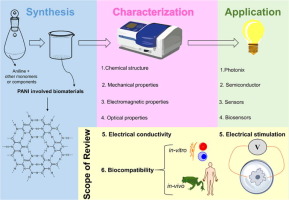当前位置:
X-MOL 学术
›
Eur. Polym. J.
›
论文详情
Our official English website, www.x-mol.net, welcomes your feedback! (Note: you will need to create a separate account there.)
Biocompatible and electroconductive polyaniline-based biomaterials for electrical stimulation
European Polymer Journal ( IF 6 ) Pub Date : 2018-11-01 , DOI: 10.1016/j.eurpolymj.2018.08.036 Yaser Arteshi , Ayuob Aghanejad , Soodabeh Davaran , Yadollah Omidi
European Polymer Journal ( IF 6 ) Pub Date : 2018-11-01 , DOI: 10.1016/j.eurpolymj.2018.08.036 Yaser Arteshi , Ayuob Aghanejad , Soodabeh Davaran , Yadollah Omidi

|
Abstract Polyaniline (PANI) involved materials have extended approved applications in different fields, including bio/chemical-sensors, electrical and electrochemical devices, electrochemically active membranes and stimuli-responsive systems. These materials have attracted most of the interest in the field of development of biomaterials for tissue engineering and drug delivery systems. PANI offers remarkable features such as the ease of synthesis, considerable electrical conductivity especially in the doped condition, simplicity in the modification to improve water processability and enhanced biocompatibility. An engineered PANI-based biomaterial can be applied in the process named the electrical stimulation (ES), in which cells cultured on the prepared biomaterial can be electrically stimulated. The ES mimics the native role of bioelectricity and affects the cellular behavior. The main focus of this review is on the electrical conductivity and stimulation using biocompatible advanced PANI-based materials, documenting and discussing the relevant literature and providing key information and new insights into ES.
中文翻译:

用于电刺激的生物相容性和导电性聚苯胺基生物材料
摘要 聚苯胺 (PANI) 所涉及的材料已扩展到不同领域的批准应用,包括生物/化学传感器、电气和电化学设备、电化学活性膜和刺激响应系统。这些材料在组织工程和药物递送系统的生物材料开发领域引起了大部分兴趣。PANI 具有显着的特性,例如易于合成、具有相当大的导电性(尤其是在掺杂条件下)、修饰简单以提高水的可加工性和增强的生物相容性。可以在称为电刺激 (ES) 的过程中应用一种基于 PANI 的工程生物材料,其中可以对在制备的生物材料上培养的细胞进行电刺激。ES 模仿生物电的天然作用并影响细胞行为。本综述的主要重点是使用基于生物相容性的先进 PANI 材料的电导率和刺激,记录和讨论相关文献,并提供关于 ES 的关键信息和新见解。
更新日期:2018-11-01
中文翻译:

用于电刺激的生物相容性和导电性聚苯胺基生物材料
摘要 聚苯胺 (PANI) 所涉及的材料已扩展到不同领域的批准应用,包括生物/化学传感器、电气和电化学设备、电化学活性膜和刺激响应系统。这些材料在组织工程和药物递送系统的生物材料开发领域引起了大部分兴趣。PANI 具有显着的特性,例如易于合成、具有相当大的导电性(尤其是在掺杂条件下)、修饰简单以提高水的可加工性和增强的生物相容性。可以在称为电刺激 (ES) 的过程中应用一种基于 PANI 的工程生物材料,其中可以对在制备的生物材料上培养的细胞进行电刺激。ES 模仿生物电的天然作用并影响细胞行为。本综述的主要重点是使用基于生物相容性的先进 PANI 材料的电导率和刺激,记录和讨论相关文献,并提供关于 ES 的关键信息和新见解。



























 京公网安备 11010802027423号
京公网安备 11010802027423号